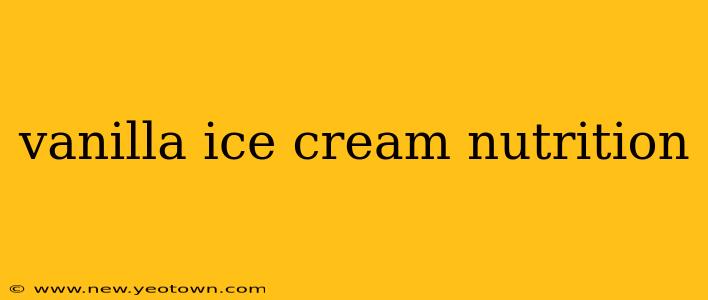Vanilla ice cream. The quintessential summer treat, the perfect dessert after a hearty meal, the comforting cold solace on a hot day. But how much do we really know about what's in that creamy, dreamy scoop? Let's delve into the nutritional details of vanilla ice cream, uncovering the good, the bad, and the creamy in between. This isn't just about calories; we'll explore the impact of different ingredients and variations to paint a complete nutritional picture.
What are the main nutritional components of vanilla ice cream?
Vanilla ice cream, at its core, is a blend of cream, milk, sugar, and flavorings. These basic components contribute the major nutrients we find in its nutritional profile. The exact amounts vary wildly depending on the brand, the specific recipe (is it a rich, custard-based ice cream, or a lighter version?), and even the size of the serving. But generally, you'll find significant amounts of:
- Fat: This comes primarily from the cream and milk, contributing to the richness and texture we all love. The fat content is a major determinant of the overall calorie count.
- Sugar: This is typically added sugar, often in the form of sucrose, corn syrup, or a combination thereof. Sugar significantly impacts the overall calorie and carbohydrate content.
- Carbohydrates: Besides sugar, some carbohydrates come from the lactose naturally present in the milk.
- Protein: This is relatively modest, mostly derived from the milk proteins.
- Calcium: A good source of calcium, especially if the ice cream uses whole milk.
How many calories are in a typical serving of vanilla ice cream?
This is a tricky question! A "typical" serving is often cited as ½ cup, but portions in restaurants or even at home can easily be much larger. A ½ cup serving of many store-bought vanilla ice creams can range from 130 to 200 calories. However, richer, premium brands, or those with added mix-ins, will have significantly more. Always check the nutrition label on your specific brand and size to know for sure. Paying close attention to serving size is crucial for managing your calorie intake.
What are the different types of vanilla ice cream, and how do they differ nutritionally?
The seemingly simple world of vanilla ice cream offers surprising variety. We have:
- Dairy-Based: This is your classic vanilla ice cream, made with cream and milk. The nutritional profile varies depending on the fat content of the milk and cream used (whole milk, 2%, skim).
- Low-Fat/Nonfat: These versions often substitute some or all of the cream with nonfat milk, resulting in lower fat and calorie content, but sometimes a less creamy texture.
- Plant-Based: Made with plant milks like almond, soy, coconut, or oat milk, these options are often lower in fat and cholesterol than dairy versions, and sometimes lower in calories, but may have a different nutritional profile regarding proteins and fats.
- Organic: Organic vanilla ice cream typically uses ingredients that meet organic farming standards, and although the nutritional information might be similar to conventional ice cream, there's the added benefit of avoiding pesticides and potentially supporting sustainable farming practices.
Does vanilla ice cream contain any vitamins or minerals?
While not a powerhouse of vitamins and minerals, vanilla ice cream does contribute some essential nutrients, mainly from the milk. You’ll find small amounts of calcium, riboflavin, and potentially some vitamin A and vitamin D, depending on whether the milk used was fortified. The amounts, however, are not significant enough to rely on ice cream as a primary source of these nutrients.
Is vanilla ice cream healthy?
This depends entirely on your definition of "healthy" and how it fits into your overall diet. In moderation, vanilla ice cream can be part of a balanced diet. However, its high sugar and fat content means it's not a daily staple for those watching their weight or managing conditions like diabetes or heart disease. Choosing lower-fat options, watching your portion sizes, and opting for ice cream that uses natural sweeteners can minimize its negative impact.
Conclusion: Enjoy in Moderation!
Vanilla ice cream offers undeniable pleasure, but understanding its nutritional profile allows for mindful consumption. By making informed choices about brand, type, and serving size, you can enjoy this beloved treat without derailing your health goals. Remember, balance is key!

